SEO
How Do I Get A Job With A PPC Agency
This month’s “Ask A PPC” question is particularly significant because the job market has been quite volatile.
“How do I get a job with a PPC agency when I have only worked in-house. What experience would they want?” – Karl Toronto
It’s understandable that people want to know which skills employers seek when hiring for a PPC team. There can be a disparity between what people think they need and what the market actually demands.
We’ll delve into some data and commentary to explain why various traits are valued.
It’s crucial to understand that the ideal candidates will be versatile and have an aptitude for all aspects of digital marketing.
However, no one can excel at everything, so leveraging your strengths or preferences is beneficial.
Ensure that you’re securing the best role for yourself while the company hiring you finds the best fit for them.
Here Are The Essential Skills
- Analytics.
- Creativity.
- Ad network knowledge.
- Willingness to test/learn.
- Culture fit.
Discrepancy Between Market Demands And Perceived Needs
I conducted a poll on my LinkedIn to gauge the skills desired by current employers and practitioners.
Analytical skills emerged as the most sought-after trait. Employers seek individuals who can interpret numbers and discern the story behind them.
However, relying solely on analytical prowess may overlook the importance of creativity.
Creative skills are vital in today’s ad networks, especially emphasizing visual content like videos and campaign types that force visual content (Performace Max/Demand Gen). Neglecting creativity can hinder a company’s branding efforts.
Unexpectedly, ad network skills and cultural fit were deemed far less critical than analytical skills. Brands should prioritize team cohesion for long-term success, yet this aspect is often undervalued.
The disparity between job descriptions and actual skill requirements contributes to the difficulty in the job market.
Agencies that hire for how PPC used to work will be left wanting. Practitioners who only focus on popular skills instead of needed ones will be made obsolete by the privacy-first era obscuring data and AI owning creative.
Analytical Skills
Analytical abilities involve knowing where to find relevant data sources and understanding how they contribute to success.
While PPC historically relied on measurable outcomes, the landscape is evolving, necessitating adaptability in data analysis. Technical proficiency and strategic acumen are crucial for navigating different data sources.
These include:
- Customer relationship management (CRM) systems.
- Google Analytics 4 (GA4).
- Ecommerce platforms.
- Content management platforms (CMS).
Empathy for various ad channels improves your candidacy, and knowing how to work with post-click data will give you an edge over those who can only work with ad platform data.
While being highly technical isn’t required, having empathy for coding and scripts will give you a better chance to stay current with evolving data mechanics (especially as APIs become even more important for accessing data blocked by privacy-first regulations).
Here are some takes from PPC experts on why analytics is the most important:
 Screenshot from author, LinkedIn, April 2024
Screenshot from author, LinkedIn, April 2024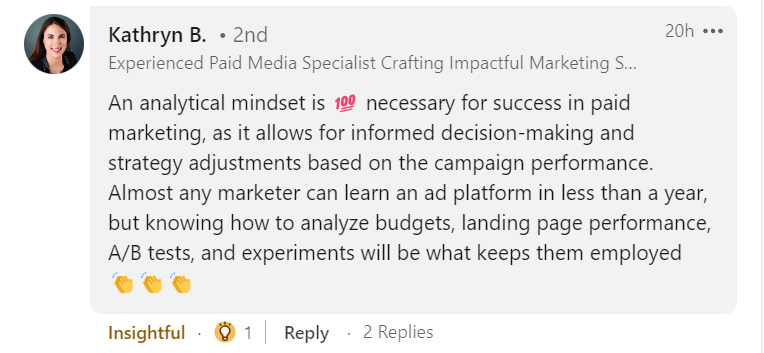 Screenshot from LinkedIn, April 2024
Screenshot from LinkedIn, April 2024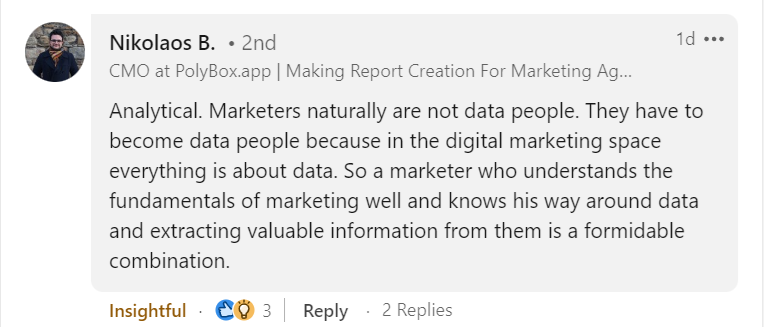 Screenshot from author, LinkedIn, April 2024
Screenshot from author, LinkedIn, April 2024Creativity
Creativity is essential for crafting compelling ad content, yet many PPC agencies struggle in this area.
Clients are often tasked with providing creative materials due to cost or complexity constraints.
You’ll get a competitive edge if you have these skills:
- Video Editing: With the rise of PMax, as well as many ad networks leaning heavily into connected TV, having video editing chops will be a huge asset for any team. If you’re not comfortable using conventional editing tools, AI tools like Descript are a great way to take on those tasks.
- Graphic Design: No matter the ad network your potential employer is hiring for, you will need some ability to design static images. Whether you use stock photos or AI-generated images or come up with the creative yourself, the days of purely text ads are over. Tools like Canva can help bridge the gap for less technical designers, but don’t discount ad network AI.
- Content Creation: While the first two categories leaned toward visual content, written content is still important (i.e., most ad formats include some text). Having the ability to understand how diverse audiences prefer to be addressed while respecting the specific requirements of each format is a great skill to hone.
While some roles may prioritize analytics or ad network knowledge, emphasizing creative abilities can distinguish you during the hiring process.
Here are some experts who value creativity:
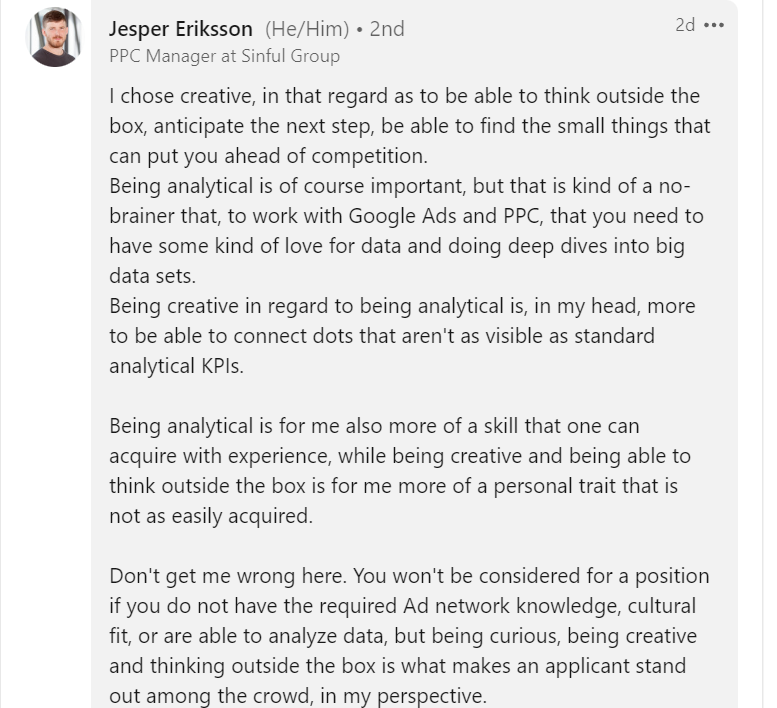 Screenshot from author, LinkedIn, April 2024
Screenshot from author, LinkedIn, April 2024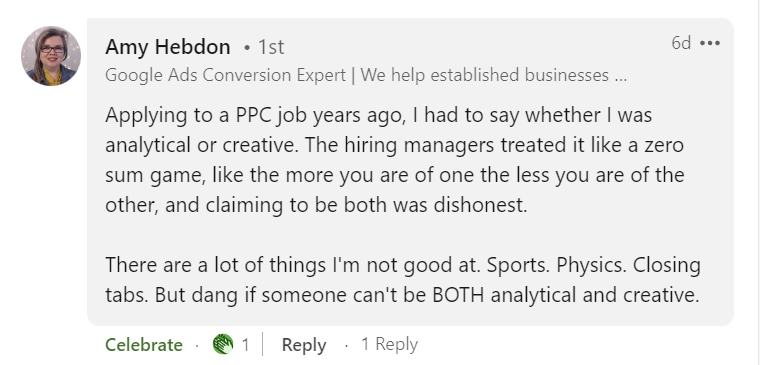 Screenshot from author, LinkedIn, April 2024
Screenshot from author, LinkedIn, April 2024Ad Network Knowledge
Ad network expertise is valuable, but adaptability is paramount as platforms evolve rapidly.
Some agencies will have specialists, while others hire folks they expect to be passable at every network they service. It’s important to understand what workflow will enable you to succeed.
If you’re happy working with all platforms, then don’t shy away from it. However, if you do better in focusing on one aspect of PPC, that’s totally valid. Just know it might limit your ability to get hired into smaller “familyesque” agencies.
Understanding auction dynamics and bidding strategies is crucial.
Many of us who entered the industry when manual bidding was more popular have an unfair advantage over those who came in during the Smart Bidding era (i.e., anything from 2020).
This is because manual bidding requires you to think about the mechanics of each ad platform’s auction and how you could use those mechanics to your advantage in building account structure.
Knowing what to track and allocating appropriate budgets are key considerations.
Understanding that some networks require more conversions than others to run (e.g., Meta Ads’ 50 in a 7-day period vs. Google Ads’ 15 in a 30-day period) should influence what you choose to track, as well as how you report the data.
Additionally, if you are under or over budget, you’ll set yourself up to fail. Knowing which channels require a big investment upfront and what the breaking point for each network is (either on underspending or spending too much) is critical.
Awareness of potential pitfalls, such as false positives or negatives, enhances campaign effectiveness. For example, it’s important to know how to check if automatically applying recommendations is on and what tasks it’s on for.
It’s worth noting that none of the experts who chimed in on the poll made a clear case for ad network knowledge specifically.
Willingness To Test
Success in PPC requires openness to experimentation and a willingness to adapt. While this wasn’t one of the criteria in the poll, it was one of the most popular traits experts look for in hiring.
Perfectionism can hinder progress in a fast-changing environment. Testing new ideas and embracing failure as an opportunity for growth are essential.
While analytical skills aid in test design, empathy and creativity are equally vital for devising effective experiments.
Here is an expert who favors a willingness to test:
 Screenshot from author, LinkedIn, April 2024
Screenshot from author, LinkedIn, April 2024Cultural Fit
Cultural alignment with an agency fosters productivity and job satisfaction. However, you can only achieve that by being honest with yourself about what you want and the mechanics of how you work.
Agencies demand intense effort and collaboration, making compatibility with colleagues crucial.
Anyone looking to make the shift from in-house to agency needs to be prepared for a much faster pace of work and a lot more agency.
Open communication with leadership regarding preferred management and learning styles will ensure a positive working relationship.
Respect for peers and a supportive atmosphere contribute to a fulfilling work environment.
Here are a few thoughts on cultural fit from polled experts:
 Screenshot from author, LinkedIn, April 2024
Screenshot from author, LinkedIn, April 2024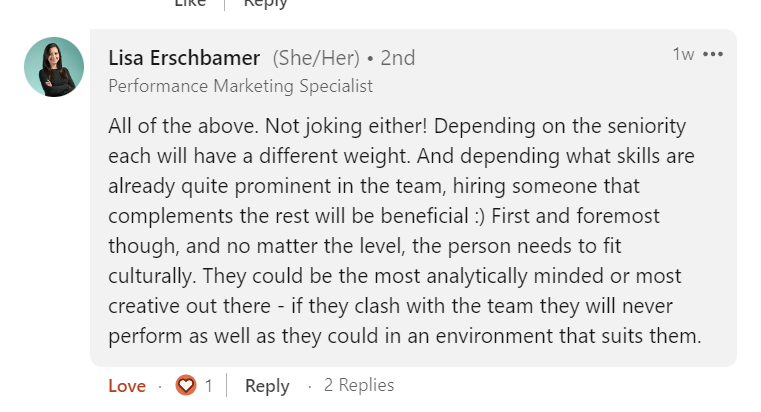 Screenshot from author, LinkedIn, April 2024
Screenshot from author, LinkedIn, April 2024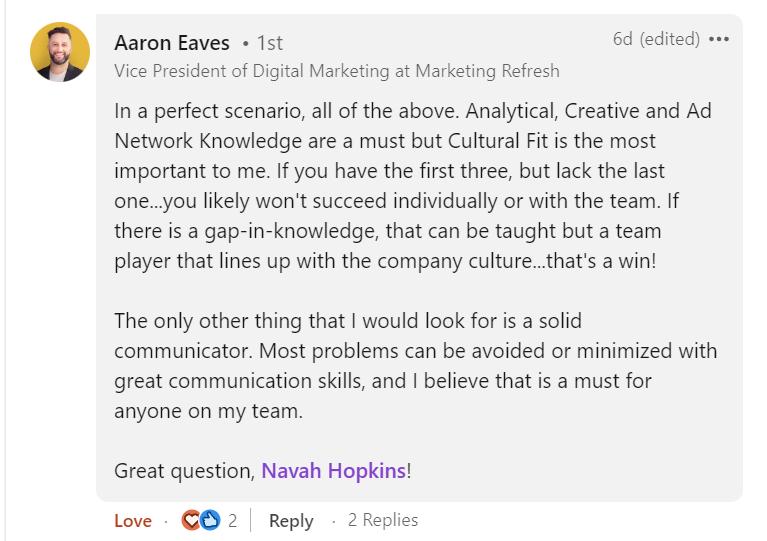 Screenshot from author, LinkedIn, April 2024
Screenshot from author, LinkedIn, April 2024Final Thoughts
Navigating the current job market can be challenging, but understanding industry needs and honing relevant skills increases your chances of success.
Balancing technical proficiency with creativity and cultural fit is essential for thriving in a PPC role. By aligning with market demands and showcasing your strengths, you can secure rewarding opportunities in the field.
Have a question you’d like us to address? Fill out the form!
More resources:
Featured Image: Paulo Bobita/Search Engine Journal
SEO
Google Cautions On Blocking GoogleOther Bot

Google’s Gary Illyes answered a question about the non-search features that the GoogleOther crawler supports, then added a caution about the consequences of blocking GoogleOther.
What Is GoogleOther?
GoogleOther is a generic crawler created by Google for the various purposes that fall outside of those of bots that specialize for Search, Ads, Video, Images, News, Desktop and Mobile. It can be used by internal teams at Google for research and development in relation to various products.
The official description of GoogleOther is:
“GoogleOther is the generic crawler that may be used by various product teams for fetching publicly accessible content from sites. For example, it may be used for one-off crawls for internal research and development.”
Something that may be surprising is that there are actually three kinds of GoogleOther crawlers.
Three Kinds Of GoogleOther Crawlers
- GoogleOther
Generic crawler for public URLs - GoogleOther-Image
Optimized to crawl public image URLs - GoogleOther-Video
Optimized to crawl public video URLs
All three GoogleOther crawlers can be used for research and development purposes. That’s just one purpose that Google publicly acknowledges that all three versions of GoogleOther could be used for.
What Non-Search Features Does GoogleOther Support?
Google doesn’t say what specific non-search features GoogleOther supports, probably because it doesn’t really “support” a specific feature. It exists for research and development crawling which could be in support of a new product or an improvement in a current product, it’s a highly open and generic purpose.
This is the question asked that Gary narrated:
“What non-search features does GoogleOther crawling support?”
Gary Illyes answered:
“This is a very topical question, and I think it is a very good question. Besides what’s in the public I don’t have more to share.
GoogleOther is the generic crawler that may be used by various product teams for fetching publicly accessible content from sites. For example, it may be used for one-off crawls for internal research and development.
Historically Googlebot was used for this, but that kind of makes things murky and less transparent, so we launched GoogleOther so you have better controls over what your site is crawled for.
That said GoogleOther is not tied to a single product, so opting out of GoogleOther crawling might affect a wide range of things across the Google universe; alas, not Search, search is only Googlebot.”
It Might Affect A Wide Range Of Things
Gary is clear that blocking GoogleOther wouldn’t have an affect on Google Search because Googlebot is the crawler used for indexing content. So if blocking any of the three versions of GoogleOther is something a site owner wants to do, then it should be okay to do that without a negative effect on search rankings.
But Gary also cautioned about the outcome that blocking GoogleOther, saying that it would have an effect on other products and services across Google. He didn’t state which other products it could affect nor did he elaborate on the pros or cons of blocking GoogleOther.
Pros And Cons Of Blocking GoogleOther
Whether or not to block GoogleOther doesn’t necessarily have a straightforward answer. There are several considerations to whether doing that makes sense.
Pros
Inclusion in research for a future Google product that’s related to search (maps, shopping, images, a new feature in search) could be useful. It might be helpful to have a site included in that kind of research because it might be used for testing something good for a site and be one of the few sites chosen to test a feature that could increase earnings for a site.
Another consideration is that blocking GoogleOther to save on server resources is not necessarily a valid reason because GoogleOther doesn’t seem to crawl so often that it makes a noticeable impact.
If blocking Google from using site content for AI is a concern then blocking GoogleOther will have no impact on that at all. GoogleOther has nothing to do with crawling for Google Gemini apps or Vertex AI, including any future products that will be used for training associated language models. The bot for that specific use case is Google-Extended.
Cons
On the other hand it might not be helpful to allow GoogleOther if it’s being used to test something related to fighting spam and there’s something the site has to hide.
It’s possible that a site owner might not want to participate if GoogleOther comes crawling for market research or for training machine learning models (for internal purposes) that are unrelated to public-facing products like Gemini and Vertex.
Allowing GoogleOther to crawl a site for unknown purposes is like giving Google a blank check to use your site data in any way they see fit outside of training public-facing LLMs or purposes related to named bots like GoogleBot.
Takeaway
Should you block GoogleOther? It’s a coin toss. There are possible potential benefits but in general there isn’t enough information to make an informed decision.
Listen to the Google SEO Office Hours podcast at the 1:30 minute mark:
Featured Image by Shutterstock/Cast Of Thousands
SEO
AI Search Boosts User Satisfaction

A new study finds that despite concerns about AI in online services, users are more satisfied with search engines and social media platforms than before.
The American Customer Satisfaction Index (ACSI) conducted its annual survey of search and social media users, finding that satisfaction has either held steady or improved.
This comes at a time when major tech companies are heavily investing in AI to enhance their services.
Search Engine Satisfaction Holds Strong
Google, Bing, and other search engines have rapidly integrated AI features into their platforms over the past year. While critics have raised concerns about potential negative impacts, the ACSI study suggests users are responding positively.
Google maintains its position as the most satisfying search engine with an ACSI score of 81, up 1% from last year. Users particularly appreciate its AI-powered features.
Interestingly, Bing and Yahoo! have seen notable improvements in user satisfaction, notching 3% gains to reach scores of 77 and 76, respectively. These are their highest ACSI scores in over a decade, likely due to their AI enhancements launched in 2023.
The study hints at the potential of new AI-enabled search functionality to drive further improvements in the customer experience. Bing has seen its market share improve by small but notable margins, rising from 6.35% in the first quarter of 2023 to 7.87% in Q1 2024.
Customer Experience Improvements
The ACSI study shows improvements across nearly all benchmarks of the customer experience for search engines. Notable areas of improvement include:
- Ease of navigation
- Ease of using the site on different devices
- Loading speed performance and reliability
- Variety of services and information
- Freshness of content
These improvements suggest that AI enhancements positively impact various aspects of the search experience.
Social Media Sees Modest Gains
For the third year in a row, user satisfaction with social media platforms is on the rise, increasing 1% to an ACSI score of 74.
TikTok has emerged as the new industry leader among major sites, edging past YouTube with a score of 78. This underscores the platform’s effective use of AI-driven content recommendations.
Meta’s Facebook and Instagram have also seen significant improvements in user satisfaction, showing 3-point gains. While Facebook remains near the bottom of the industry at 69, Instagram’s score of 76 puts it within striking distance of the leaders.
Challenges Remain
Despite improvements, the study highlights ongoing privacy and advertising challenges for search engines and social media platforms. Privacy ratings for search engines remain relatively low but steady at 79, while social media platforms score even lower at 73.
Advertising experiences emerge as a key differentiator between higher- and lower-satisfaction brands, particularly in social media. New ACSI benchmarks reveal user concerns about advertising content’s trustworthiness and personal relevance.
Why This Matters For SEO Professionals
This study provides an independent perspective on how users are responding to the AI push in online services. For SEO professionals, these findings suggest that:
- AI-enhanced search features resonate with users, potentially changing search behavior and expectations.
- The improving satisfaction with alternative search engines like Bing may lead to a more diverse search landscape.
- The continued importance of factors like content freshness and site performance in user satisfaction aligns with long-standing SEO best practices.
As AI becomes more integrated into our online experiences, SEO strategies may need to adapt to changing user preferences.
Featured Image: kate3155/Shutterstock
SEO
Google To Upgrade All Retailers To New Merchant Center By September

Google has announced plans to transition all retailers to its updated Merchant Center platform by September.
This move will affect e-commerce businesses globally and comes ahead of the holiday shopping season.
The Merchant Center is a tool for online retailers to manage how their products appear across Google’s shopping services.
Key Changes & Features
The new Merchant Center includes several significant updates.
Product Studio
An AI-powered tool for content creation. Google reports that 80% of current users view it as improving efficiency.
This feature allows retailers to generate tailored product assets, animate still images, and modify existing product images to match brand aesthetics.
It also simplifies tasks like background removal and image resolution enhancement.
Centralized Analytics
A new tab consolidating various business insights, including pricing data and competitive analysis tools.
Retailers can access pricing recommendations, competitive visibility reports, and retail-specific search trends, enabling them to make data-driven decisions and capitalize on popular product categories.
Redesigned Navigation
Google claims the new interface is more intuitive and cites increased setup success rates for new merchants.
The platform now offers simplified website verification processes and can pre-populate product information during setup.
Initial User Response
According to Google, early adopters have shown increased engagement with the platform.
The company reports a 25% increase in omnichannel merchants adding product offers in the new system. However, these figures have yet to be independently verified.
Jeff Harrell, Google’s Senior Director of Merchant Shopping, states in an announcement:
“We’ve seen a significant increase in retention and engagement among existing online merchants who have moved to the new Merchant Center.”
Potential Challenges and Support
While Google emphasizes the upgrade’s benefits, some retailers, particularly those comfortable with the current version, may face challenges adapting to the new system.
The upgrade’s mandatory nature could raise concerns among users who prefer the existing interface or have integrated workflows based on the current system.
To address these concerns, Google has stated that it will provide resources and support to help with the transition. This includes tutorial videos, detailed documentation, and access to customer support teams for troubleshooting.
Industry Context
This update comes as e-commerce platforms evolve, with major players like Amazon and Shopify enhancing their seller tools. Google’s move is part of broader efforts to maintain competitiveness in the e-commerce services sector.
The upgrade could impact consumers by improving product listings and providing more accurate information across Google’s shopping services.
For the e-commerce industry as a whole, it signals a continued push towards AI-driven tools and data-centric decision-making.
Transition Timeline
Google states that retailers will be automatically upgraded by September if they still need to transition.
The company advises users to familiarize themselves with the new features before the busy holiday shopping period.
Featured Image: BestForBest/Shutterstock
-

 SEARCHENGINES6 days ago
SEARCHENGINES6 days agoBillions Of Google goo.gl URLs To 404 In The Future
-
SEARCHENGINES5 days ago
Daily Search Forum Recap: July 22, 2024
-

 SEARCHENGINES7 days ago
SEARCHENGINES7 days agoGoogle Core Update Coming, Ranking Volatility, Bye Search Notes, AI Overviews, Ads & More
-

 SEO6 days ago
SEO6 days ago11 Copyscape Alternatives To Check Plagiarism
-

 SEO6 days ago
SEO6 days agoGoogle Warns Of Last Chance To Export Notes Search Data
-
SEARCHENGINES4 days ago
Daily Search Forum Recap: July 23, 2024
-

 AFFILIATE MARKETING6 days ago
AFFILIATE MARKETING6 days agoThe Top 5 AI Tools That Can Revolutionize Your Workflow and Boost Productivity
-

 SEO4 days ago
SEO4 days agoSystem Builders – How AI Changes The Work Of SEO















